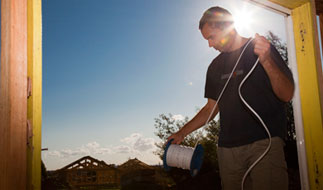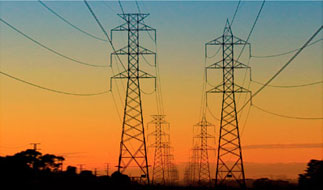OHS practices - Hazards
Radiation
Radiation is part of our world and is produced by all kinds of things: sunlight, television, radios, microwave ovens, visual display units (VDUs) and even some building materials, like bricks and rocks.
Some effects of radiation are good, but all forms can be harmful.
Radiation can be divided into ionising and non-ionising radiation. Non-ionising radiation is also known as electro-magnetic radiation.


Radiation from the sun and radiation from power lines
Radiation may be encountered in the following industries:
- power industry - electric fields around transmission lines and switching yards
- telecommunications industry - radio lines, microwave, point to point transmitters, radio and TV broadcast aerials.
The health hazards of radiation include:
- general toxicity
- cancer (linked with exposure to electric fields, to MW/RF radiation, to UV radiation and to ionising radiation)
- cataract of the lens of the eye, damage to the retina
- sterility
- birth deformities
- blood changes and alteration of immune response
- cardiovascular changes
- nervous system effects and behavioural changes
- skin burns.
Prevention of radiation requires:
- radiation survey of the workplace; that no process / product emitting radiation be installed in a workplace without addressing the health hazards
- implementation of engineering controls
- if necessary, administrative control and protective gear to reduce exposure levels below recommended standards (if such exist)
- regular medical monitoring of all exposed persons
- provision of information on radiation hazards and adequate training (see relevant Australian Standard)
- adequate lock out and safe entry procedures during maintenance
- clearly posted warning signs and labels
- provision of personal protective equipment.



